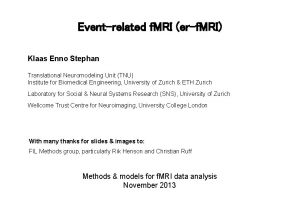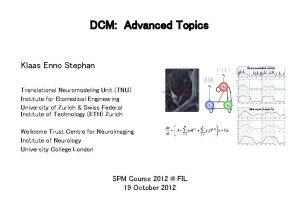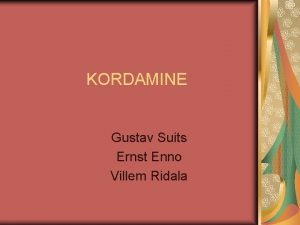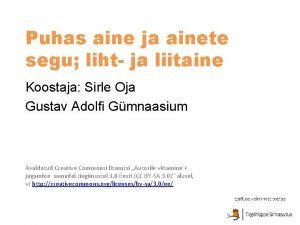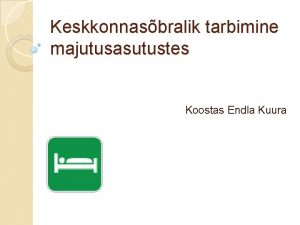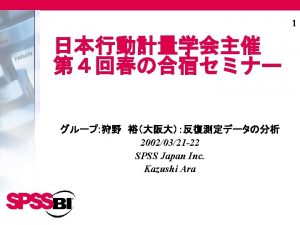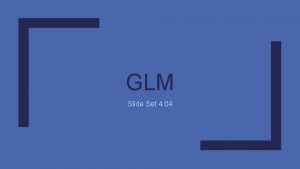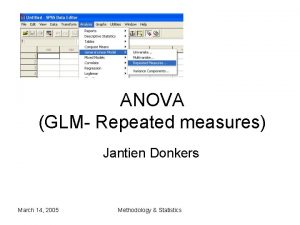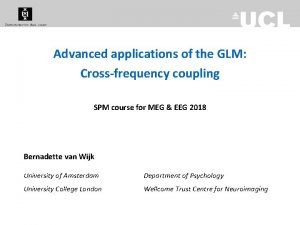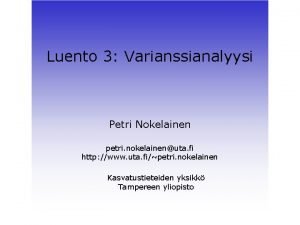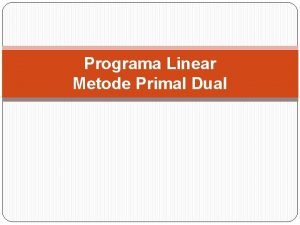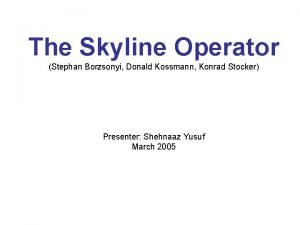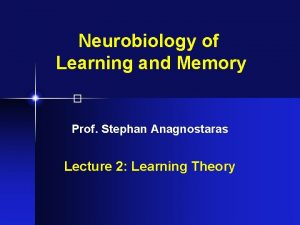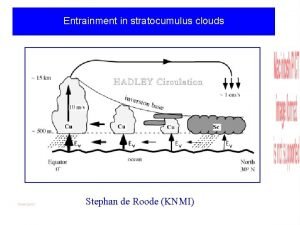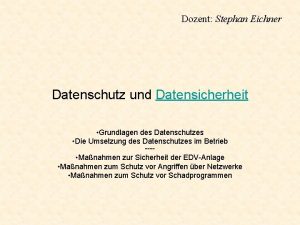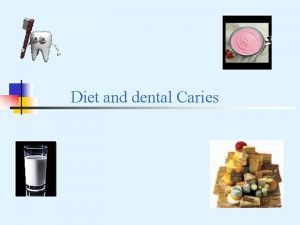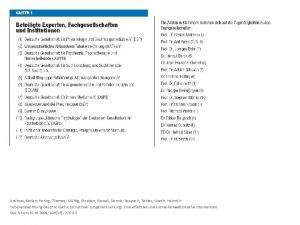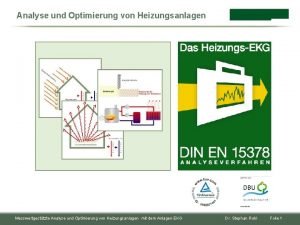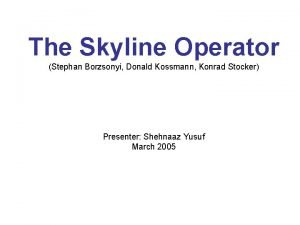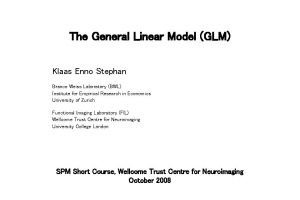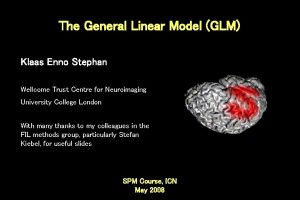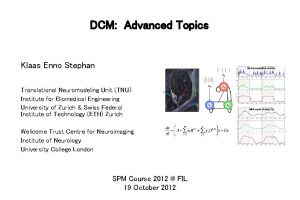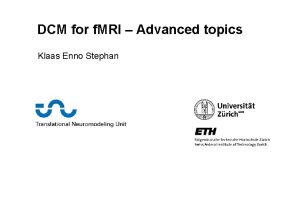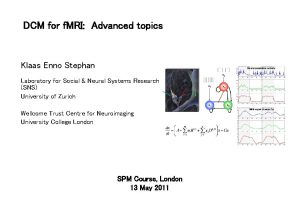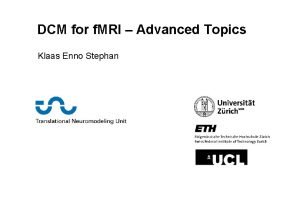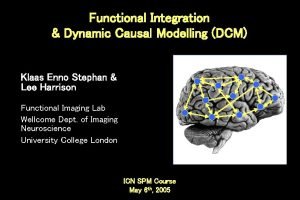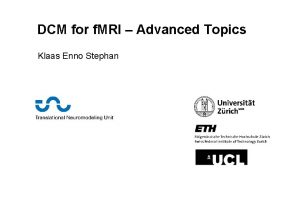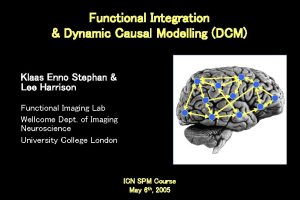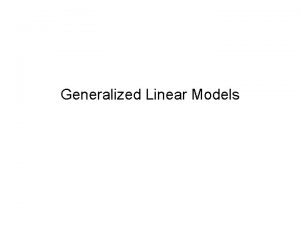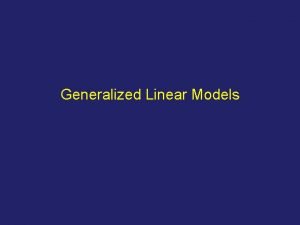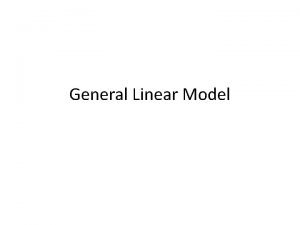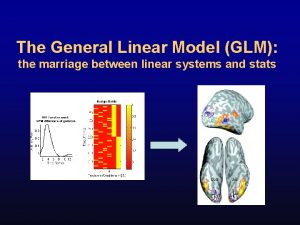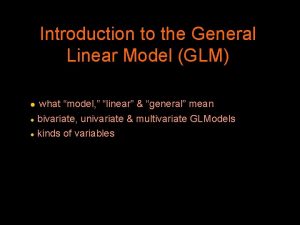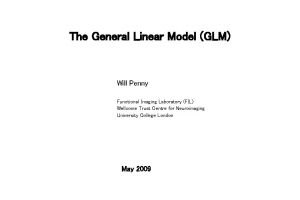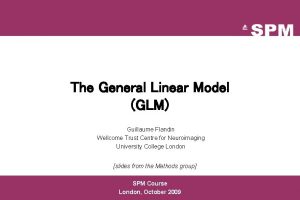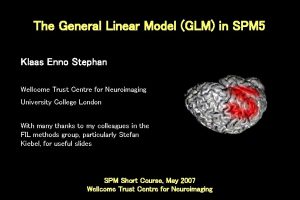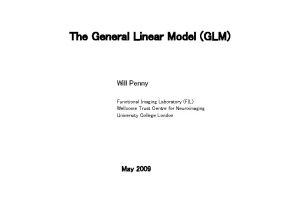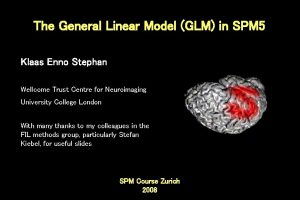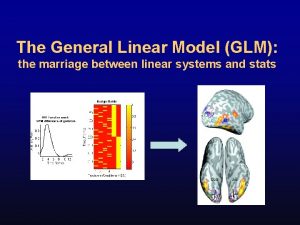The General Linear Model GLM Klaas Enno Stephan































- Slides: 31

The General Linear Model (GLM) Klaas Enno Stephan Laboratory for Social & Neural Systems Research Institute for Empirical Research in Economics University of Zurich With many thanks for slides & images to: FIL Methods group Functional Imaging Laboratory (FIL) Wellcome Trust Centre for Neuroimaging University College London Zurich SPM Course 2011 16 -18 February

Overview of SPM Image time-series Realignment Kernel Smoothing Design matrix Statistical parametric map (SPM) General linear model Statistical inference Normalisation Gaussian field theory p <0. 05 Template Parameter estimates

A very simple f. MRI experiment One session Passive word listening versus rest 7 cycles of rest and listening Blocks of 6 scans with 7 sec TR Stimulus function Question: Is there a change in the BOLD response between listening and rest?

Modelling the measured data Why? Make inferences about effects of interest How? 1. Decompose data into effects and error 2. Form statistic using estimates of effects and error stimulus function data linear model effects estimate error estimate statistic

Voxel-wise time series analysis model specification Time parameter estimation hypothesis statistic e m Ti BOLD signal single voxel time series SPM

Time = 1 BOLD signal + 2 x 1 + x 2 error Single voxel regression model e

Mass-univariate analysis: voxel-wise GLM y = X + Model is specified by 1. Design matrix X 2. Assumptions about e N: number of scans p: number of regressors The design matrix embodies all available knowledge about experimentally controlled factors and potential confounds.

GLM assumes Gaussian “spherical” (i. i. d. ) errors sphericity = i. i. d. error covariance is scalar multiple of identity matrix: Cov(e) = 2 I Examples for non-sphericity: non-identity non-independence

Parameter estimation Objective: estimate parameters to minimize = y + X Ordinary least squares estimation (OLS) (assuming i. i. d. error):

A geometric perspective on the GLM OLS estimates Residual forming matrix R y e x 2 x 1 Design space defined by X Projection matrix P

Deriving the OLS equation OLS estimate

Correlated and orthogonal regressors y x 2* Correlated regressors = explained variance is shared between regressors x 2 x 1 When x 2 is orthogonalized with regard to x 1, only the parameter estimate for x 1 changes, not that for x 2!

What are the problems of this model? 1. BOLD responses have a delayed and dispersed form. 2. The BOLD signal includes substantial amounts of low-frequency noise. 3. The data are serially correlated (temporally autocorrelated) this violates the assumptions of the noise model in the GLM HRF

Problem 1: Shape of BOLD response Solution: Convolution model hemodynamic response function (HRF) The response of a linear time-invariant (LTI) system is the convolution of the input with the system's response to an impulse (delta function). expected BOLD response = input function impulse response function (HRF)

Convolution model of the BOLD response Convolve stimulus function with a canonical hemodynamic response function (HRF): HRF

Problem 2: Low-frequency noise Solution: High pass filtering S = residual forming matrix of DCT set discrete cosine transform (DCT) set

High pass filtering: example blue = data black = mean + low-frequency drift green = predicted response, taking into account low-frequency drift red = predicted response, NOT taking into account low-frequency drift

Problem 3: Serial correlations with 1 st order autoregressive process: AR(1) autocovariance function

Dealing with serial correlations • Pre-colouring: impose some known autocorrelation structure on the data (filtering with matrix W) and use Satterthwaite correction for df’s. • Pre-whitening: 1. Use an enhanced noise model with multiple error covariance components, i. e. e ~ N(0, 2 V) instead of e ~ N(0, 2 I). 2. Use estimated serial correlation to specify filter matrix W for whitening the data.

How do we define W ? • Enhanced noise model • Remember linear transform for Gaussians • Choose W such that error covariance becomes spherical • Conclusion: W is a simple function of V so how do we estimate V ?

Estimating V: Multiple covariance components enhanced noise model V = 1 error covariance components Q and hyperparameters Q 1 + 2 Q 2 Estimation of hyperparameters with Re. ML (restricted maximum likelihood).

Contrasts & statistical parametric maps c=100000 Q: activation during listening ? Null hypothesis:

t-statistic based on ML estimates c=100000 For brevity: Re. MLestimates

Physiological confounds • head movements • arterial pulsations (particularly bad in brain stem) • breathing • eye blinks (visual cortex) • adaptation effects, fatigue, fluctuations in concentration, etc.

Outlook: further challenges • correction for multiple comparisons • variability in the HRF across voxels • slice timing • limitations of frequentist statistics Bayesian analyses • GLM ignores interactions among voxels models of effective connectivity These issues are discussed in future lectures.

Correction for multiple comparisons • Mass-univariate approach: We apply the GLM to each of a huge number of voxels (usually > 100, 000). • Threshold of p<0. 05 more than 5000 voxels significant by chance! • Massive problem with multiple comparisons! • Solution: Gaussian random field theory

Variability in the HRF • HRF varies substantially across voxels and subjects • For example, latency can differ by ± 1 second • Solution: use multiple basis functions • See talk on event-related f. MRI

Summary • Mass-univariate approach: same GLM for each voxel • GLM includes all known experimental effects and confounds • Convolution with a canonical HRF • High-pass filtering to account for low-frequency drifts • Estimation of multiple variance components (e. g. to account for serial correlations)

Bibliography • Friston, Ashburner, Kiebel, Nichols, Penny (2007) Statistical Parametric Mapping: The Analysis of Functional Brain Images. Elsevier. • Christensen R (1996) Plane Answers to Complex Questions: Theory of Linear Models. Springer. • Friston KJ et al. (1995) Statistical parametric maps in functional imaging: a general linear approach. Human Brain Mapping 2: 189 -210.

Supplementary slides

Convolution step-by-step (from Wikipedia): 1. Express each function in terms of a dummy variable τ. 2. Reflect one of the functions: g(τ)→g( − τ). 3. Add a time-offset, t, which allows g(t − τ) to slide along the τ-axis. 4. Start t at -∞ and slide it all the way to +∞. Wherever the two functions intersect, find the integral of their product. In other words, compute a sliding, weighted-average of function f(τ), where the weighting function is g( − τ). The resulting waveform (not shown here) is the convolution of functions f and g. If f(t) is a unit impulse, the result of this process is simply g(t), which is therefore called the impulse response.
 Hrf
Hrf Visuo motor
Visuo motor Enno winkler
Enno winkler Enno nõmm
Enno nõmm Enno meijers
Enno meijers Magister dorenweerd
Magister dorenweerd 3 strikes law
3 strikes law Liitaine
Liitaine Klaas pel
Klaas pel Keskonnaprobleemidele
Keskonnaprobleemidele Unconditional growth model
Unconditional growth model Dot product glm
Dot product glm March
March Do
Do Frederike petzschner
Frederike petzschner Glm cross
Glm cross Minitab general linear model
Minitab general linear model Nominaaliasteikollinen muuttuja
Nominaaliasteikollinen muuttuja Linear communication model
Linear communication model Metode primal dual dapat d diselesainakan dengan
Metode primal dual dapat d diselesainakan dengan Skyline operator
Skyline operator Stephan anagnostaras
Stephan anagnostaras Stephan de roode
Stephan de roode Stephan eichner
Stephan eichner Stephan curve of dental caries pdf
Stephan curve of dental caries pdf Stephan matrakchine
Stephan matrakchine Stephan nowak
Stephan nowak Stephan ruhl
Stephan ruhl Yasmine stephan
Yasmine stephan Stephan griebel
Stephan griebel Stephan börzsönyi
Stephan börzsönyi Stephan shore
Stephan shore
